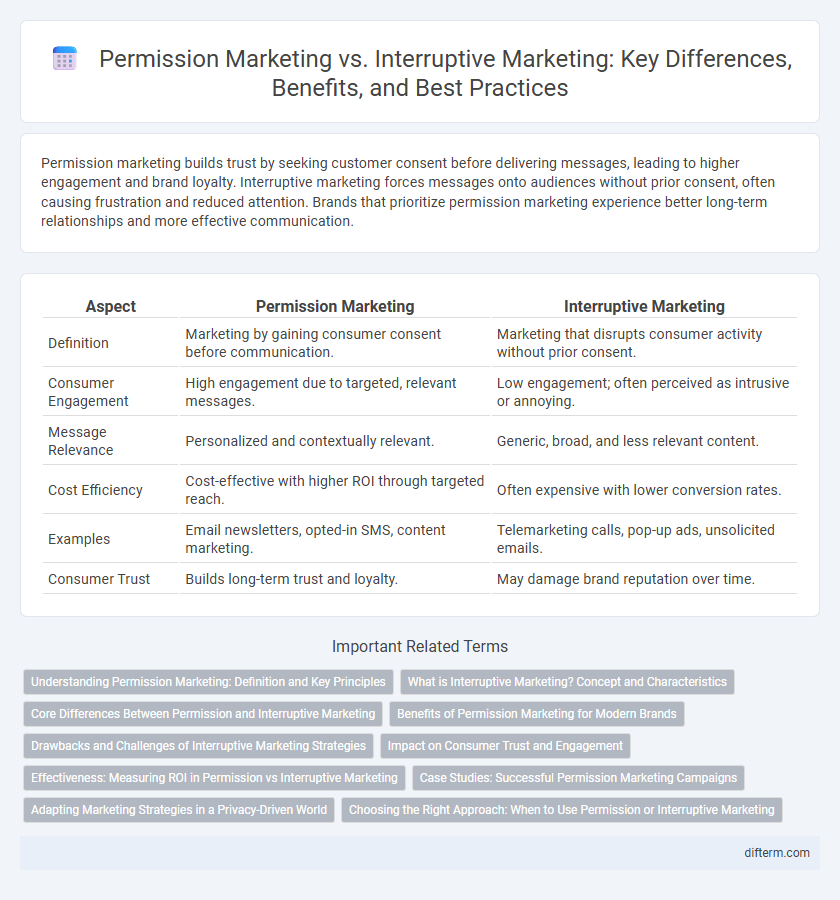Permission marketing builds trust by seeking customer consent before delivering messages, leading to higher engagement and brand loyalty. Interruptive marketing forces messages onto audiences without prior consent, often causing frustration and reduced attention. Brands that prioritize permission marketing experience better long-term relationships and more effective communication.
Table of Comparison
| Aspect | Permission Marketing | Interruptive Marketing |
|---|---|---|
| Definition | Marketing by gaining consumer consent before communication. | Marketing that disrupts consumer activity without prior consent. |
| Consumer Engagement | High engagement due to targeted, relevant messages. | Low engagement; often perceived as intrusive or annoying. |
| Message Relevance | Personalized and contextually relevant. | Generic, broad, and less relevant content. |
| Cost Efficiency | Cost-effective with higher ROI through targeted reach. | Often expensive with lower conversion rates. |
| Examples | Email newsletters, opted-in SMS, content marketing. | Telemarketing calls, pop-up ads, unsolicited emails. |
| Consumer Trust | Builds long-term trust and loyalty. | May damage brand reputation over time. |
Understanding Permission Marketing: Definition and Key Principles
Permission marketing is a strategy where businesses obtain explicit consent from consumers before delivering promotional messages, fostering trust and engagement. Key principles include personalization, targeted communication, and customer control over the interaction frequency and content. This method contrasts with interruptive marketing by prioritizing recipient relevance and consent, leading to higher conversion rates and customer loyalty.
What is Interruptive Marketing? Concept and Characteristics
Interruptive marketing is a strategy that captures consumer attention by disrupting their activities with unsolicited advertisements, such as TV commercials, pop-up ads, and cold calls. This approach is characterized by its aggressive nature, relying on broad audience targeting without prior consent, often leading to lower engagement and potential annoyance. It contrasts with permission marketing by prioritizing visibility over user consent, frequently resulting in decreased effectiveness and increased consumer resistance.
Core Differences Between Permission and Interruptive Marketing
Permission marketing builds relationships by obtaining consumer consent before delivering targeted messages, enhancing engagement and trust. Interruptive marketing relies on unsolicited ads that disrupt audience activities, often causing annoyance and lower brand affinity. The core difference lies in consumer control: permission marketing respects user preferences while interruptive marketing prioritizes message exposure without prior approval.
Benefits of Permission Marketing for Modern Brands
Permission marketing enhances customer trust and engagement by allowing brands to communicate with audiences who have expressed interest, leading to higher conversion rates and stronger loyalty. Modern brands benefit from personalized messaging and targeted campaigns, which reduce marketing costs and improve ROI compared to interruptive methods. Data-driven permission marketing strategies foster long-term relationships and brand advocacy by respecting consumer preferences and minimizing intrusion.
Drawbacks and Challenges of Interruptive Marketing Strategies
Interruptive marketing strategies often face significant challenges such as consumer annoyance and ad fatigue, leading to lower engagement rates and increased ad avoidance behaviors. These tactics can disrupt user experiences, damaging brand reputation and resulting in higher costs with diminishing returns. The inefficiency of interruptive methods is compounded by growing ad-blocker usage and stricter regulations on unsolicited advertising.
Impact on Consumer Trust and Engagement
Permission marketing enhances consumer trust by prioritizing consent and delivering relevant content, which fosters deeper engagement and brand loyalty. Interruptive marketing often disrupts the consumer experience, leading to lower trust levels and reduced engagement due to perceived annoyance. Brands leveraging permission marketing see higher click-through rates and customer retention compared to those relying on interruptive tactics.
Effectiveness: Measuring ROI in Permission vs Interruptive Marketing
Permission marketing yields higher ROI by targeting engaged consumers who have opted in, resulting in increased conversion rates and lower acquisition costs. Interruptive marketing often incurs higher expenses due to broad, unsolicited messaging that may lead to consumer irritation and decreased engagement. Analyzing metrics such as click-through rates, customer lifetime value, and engagement levels reveals permission marketing's superior effectiveness in driving long-term profitability.
Case Studies: Successful Permission Marketing Campaigns
Case studies reveal that successful permission marketing campaigns, such as Airbnb's personalized email strategy and Spotify's targeted playlists, significantly boost user engagement and conversion rates by delivering tailored content to opt-in audiences. These campaigns leverage data-driven insights to respect consumer preferences, resulting in higher brand loyalty and customer retention compared to traditional interruptive marketing methods. The emphasis on consent and relevance in permission marketing consistently proves more effective in building long-term customer relationships across industries.
Adapting Marketing Strategies in a Privacy-Driven World
Permission marketing leverages user consent to deliver personalized messages, enhancing engagement by respecting privacy preferences and building trust, which is crucial amid tighter data regulations like GDPR and CCPA. Interruptive marketing, characterized by unsolicited ads, faces declining effectiveness due to consumer resistance and increased use of ad blockers. Adapting strategies involves prioritizing transparent data practices and opt-in methods, enabling marketers to create relevant content that aligns with privacy expectations while maintaining compliance and fostering long-term customer relationships.
Choosing the Right Approach: When to Use Permission or Interruptive Marketing
Permission marketing excels in building long-term customer relationships by targeting audiences who have explicitly opted in, making it ideal for personalized campaigns and nurturing leads. Interruptive marketing proves effective for broad brand awareness and quick impact, especially when launching new products or capturing attention in saturated markets. Marketers should analyze campaign goals, audience readiness, and budget constraints to decide between permission-based strategies that emphasize consent and engagement or interruptive tactics that rely on wide reach and immediate visibility.
Permission Marketing vs Interruptive Marketing Infographic

 difterm.com
difterm.com